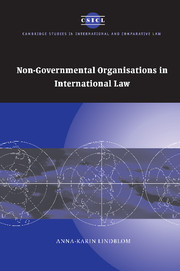Book contents
- Frontmatter
- Contents
- Acknowledgements
- List of abbreviations
- Part I Theoretical framework
- Part II Legal and empirical survey
- 4 Rights and obligations
- 5 Standing before international judicial and quasi-judicial bodies
- 6 Non-party participation before judicial and quasi-judicial bodies
- 7 Co-operation with intergovernmental organisations
- 8 Participation in international conferences
- 9 Agreements with states and intergovernmental organisations
- Part III Conclusion
- Bibliography
- Interviews
- Index
- CAMBRIDGE STUDIES IN INTERNATIONAL AND COMPARATIVE LAW
8 - Participation in international conferences
Published online by Cambridge University Press: 12 August 2009
- Frontmatter
- Contents
- Acknowledgements
- List of abbreviations
- Part I Theoretical framework
- Part II Legal and empirical survey
- 4 Rights and obligations
- 5 Standing before international judicial and quasi-judicial bodies
- 6 Non-party participation before judicial and quasi-judicial bodies
- 7 Co-operation with intergovernmental organisations
- 8 Participation in international conferences
- 9 Agreements with states and intergovernmental organisations
- Part III Conclusion
- Bibliography
- Interviews
- Index
- CAMBRIDGE STUDIES IN INTERNATIONAL AND COMPARATIVE LAW
Summary
Introduction
One of the most obvious examples of increasing contacts between NGOs and IGOs during the 1990s was the participation of NGOs in international conferences. The rules which provide NGOs with the possibility to participate in such meetings probably provide the most important formal platform for NGOs which seek to influence international law-making. While rules which give NGOs standing as victims, complainants or amici curiae before international courts and quasijudicial bodies are essential avenues for influencing the interpretation and development of already existing law, many international conferences create new law. The participation of NGOs in the conferences which adopted the Landmines Convention, the Statute of the International Court and, to some extent, environmental treaties such as the Framework Convention for Climate Change, therefore in a sense provide more direct examples of how NGOs influence law-making.
This chapter includes a description of the rules for and actual participation of NGOs in a few selected UN conferences. The limitation to UN conferences is mainly due to the universal character of these conferences, but also to the practical aspect of availability of documents and to the need for limitations. Among many possible UN conferences, I have decided to focus on the United Nations Rio Conference on Environment and Development UNCED, (1992), the World Conference on Human Rights (1993), the Third Session of the Conference of the Parties to the Framework Convention on Climate Change (FCCC, which adopted the Kyoto Protocol) (1997) and the Rome Conference for an International Criminal Court (1998).
- Type
- Chapter
- Information
- Non-Governmental Organisations in International Law , pp. 446 - 486Publisher: Cambridge University PressPrint publication year: 2006

